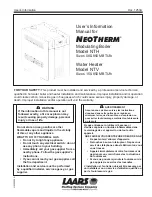
Page of 33
11
7.
GAS INSTALLATION
Shielding gas cylinders and high pressure cylinders can explode if damaged, so treat them
carefully.
Never expose cylinders to high heat, sparks, open flames, mechanical shocks or arcs.
Do not weld on the cylinder.
Always secure cylinder upright to a cart or stationary object.
Keep cylinders away from welding or electrical circuits.
Use the proper regulators, gas hose and fittings for the specific application.
a. Connect one end of the gas hose to the gas hose connection on the back of the welder. Use a
wrench to snug up the connection.
b. Connect the other end of the gas hose to the gas hose connection on the supplied rear mount
regulator/flowgauge. Use a wrench to snug up the connection.
c. Before installing the regulator, it is good practice to make certain no debris is in the gas bottle
connection. Rotate the bottle so the gas connection is not pointing toward you or any other
person. Turn the valve on the gas bottle clockwise and quickly close. This quick thrust of gas will
clear any debris in the connection. Connect the regulator to the gas bottle connection. Use a
wrench to snug up the connection.
(1) Gas Bottle Valve
(2) Gas Flow Gauge (Set at 20 CFH)
(3) Gas Pressure Gauge
(4) Regulator
(5) Gas Flow Adjuster
(6) Gas Hose Connection
(7) Gas Cylinder
d. Open the Gas Bottle Valve on the cylinder of gas.
e. Turn the Gas Flow Adjuster on the regulator so that the gas flow rate is set at approximately 20
CFH. Make certain you are reading the correct scale on the gauge.
NOTE:
Slowly open the cylinder valve by turning it counterclockwise until the cylinder pressure gauge
registers on the first gauge of the regulator. Turn the adjustment knob clockwise (right) slowly to increase
gas flow to 20 CFH. To reduce the gas flow turn the adjustment counterclockwise (left). The gas valve
is located on the back panel of the welder and activated by the remote control. Gas flow should be
1
7
4
3
2
6
5












































